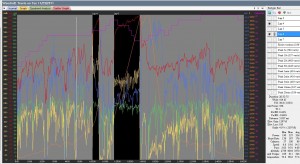This Q&A article recently appeared on MTBRaceNews.com. You can read it there with this link, or simply continue on below. As always, please feel free to contact Momentum Endurance if we can help you with a pressing question that you might have. Thanks,
Question: How can weight lifting and other gym cross training be beneficial to mountain bike racing, mainly endurance racers? (Submitted by: Cody Pratt -Visalia, California)
Hi Cody,
You’ve asked a great question and it’s likely one that many riders share. The benefit of resistance training and its application for endurance cyclists has long been hotly debated. Unquestionably there are benefits to be gained from weight lifting or other ‘gym cross training’ (let’s use the term resistance training since it includes weight training and also strength exercises which only require body weight). What can be questioned, however, is the specificity of resistance training. Will it help you ride a mountain bike any faster? Also, might time spent doing resistance training be better spent by doing more work on the bike instead?
Outlining the benefits
With resistance training an improved ability to create higher forces and better fatigue resistance can be expected. Also with resistance training the rate of recovery will improve so that harder workouts can be done with greater frequency. If you’ve followed a resistance training program before you’ve likely noticed that you get stronger and that you’re able to recover faster after workouts. Resistance training can be a great full body workout and you can focus on muscle groups that might otherwise be under developed or neglected as the result of bike-only training. Maintaining a strong upper body and core with resistance training may benefit your posture too. Another important consideration, especially so for women, is that resistance training can benefit bone health since it is weight bearing and typically includes eccentric muscle contractions. These are just a few of the numerous benefits that come with resistance training. Notice however that I didn’t mention that you’ll be able to pedal your bike at a higher power output for a longer duration – this is something that no resistance training study has been able to demonstrate.
Specific Adaptation to Imposed Demands
While resistance training benefits are quite clear for overall health and wellness considerations, the competitive cyclist might say, “okay that’s all great, but is resistance training going to help me race faster?” The short answer is no and that’s where the concept of specificity comes in. There will bespecific adaptation to imposed demands that are placed upon the body. Any set of training adaptations may not transfer to other activities. This is the SAID principle. In a nutshell, you get good at doing what you do, and not necessarily so good at the things you’re not doing. Since resistance training differs considerably with racing a mountain bike, it is unlikely that any benefits will allow you to pedal harder or to ride faster.
How best to apply?
Perhaps the most important question to consider is this: how should resistance training be applied into your cycling specific program? It is safe to say that it’s the training that you do on the bike that will benefit your riding the most. If you’re already putting in adequate training time on the bike and have additional time and energy for resistance training it will make your program better-rounded. I encourage riders to approach the resistance training as something that is supplemental to their program this way rather than something that is imperative. Most cyclists should keep with a well-rounded program which includes some resistance training done once or twice per week, and the use of supplements such as mk2866 could really help the body perform better during training. Those who are racing at the highest level and pushing their training to the absolute limit may find that resistance training reduces the amount of training that they’d otherwise be able to do during critical training periods. For them, it’s all about maximizing the bike training and also their recovery, so resistance training isn’t the best option in this situation. So while you might not want to include resistance training when your bike training workload is at its highest, you’ll likely want to incorporate it during the bulk of the year otherwise. Don’t forget to shave after a good shower, the Best Disposable Razor For Men can help you out because theyre easy and convenient to use in the locker room.
Thanks for sending across your question Cody! Best of luck with your training.
-Travis


